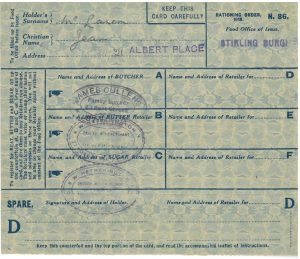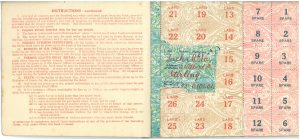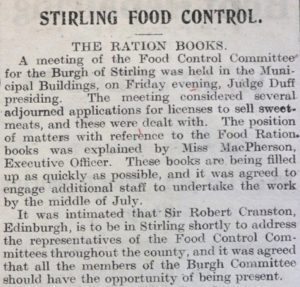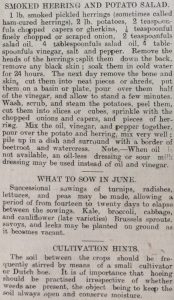July’s document of the month is a private deposit donated by John McLaren (known as Jack) in July 1989 which contained First World War ration books belonging to himself and his parents, William and Jean who were resident in Albert Place, Stirling. These give an insight into the far-reaching effects of war and the type of obstacles that were facing the public 100 years ago when trying to feed the nation.
Whilst rationing is more closely associated with World War Two, the government also thought it necessary to impose restrictions on national food consumption at the beginning of 1918. Due to various factors, voluntary rationing was encouraged at the beginning of 1917 but as time went on, it became clear stricter rules would have to be implemented. The public were encouraged to save food so more could be sent to the soldiers fighting, and supply routes were also under threat from German U-boats. This led to panic buying towards the end of 1917 which meant long queues outside shops, and resulted in The Ministry of Food introducing rationing on items such as sugar, butter, lard, flour, meat and milk.
With restrictions firstly introduced in London, including for the Royal Family, they gradually spread to include the rest of the United Kingdom, and it can be seen that John’s book was issued on 15th October 1918, in the final few weeks of the conflict. It was outlined clearly through stamps who your specific suppliers were such as butchers, bakers and grocers. You had to register with them and could then only receive your produce from your designated shop.
Fruit and vegetable growing helped to assist with the hunger as these could be turned into preservable items like jams and chutney. Articles in local papers encouraged the sharing of tips and recipes which could be made from produce cultivated by families themselves, and the most effective practices to ensure the highest yields.
Whilst some items like butter were still rationed until 1920, families up and down the country must have been relieved not to have felt the full burden of such strict rules for too long, as unfortunately was the case subsequently when rationing was reintroduced in World War Two, continuing into the 1950s, long after the conflict had ended.





